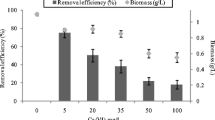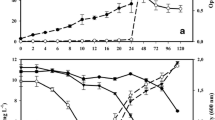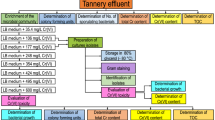Abstract
The potential of indigenously isolated bacteria from the Estância Velha stream to reduce Cr(VI) was evaluated and also the chromium contamination over the past ten years was verified in one of the most important industrial centers of Brazil, the “Brazilian Capital of Tanneries,” Estância Velha municipality in the Rio Grande do Sul State, South Brazil. Samples were collected from the Estância Velha stream at the source (P1), as well as at upstream (P2) and downstream (P3) of the most demographically area. The bacterial strains reduced between 52.5 and 61.6% of 250 mg L–1 Cr(VI) in 48 h. The genus Acinetobacter was the most abundant and could efficiently reduce 500 mg L–1 of Cr(VI); for example, P2.8 and P2.9 strains of Acinetobacter ursingii reduced 21.3 and 24.5% of 500 mg L–1 of Cr(VI), respectively, after 48 h. Moreover, an analysis of Cr levels in the stream sediment reported up to 3594 mg. L–1 of total Cr and up to 138 mg. L–1 of Cr(VI) in 2009. Acinetobacter strains were identified as the most abundant and efficient in reducing Cr(VI), makes them an ideal candidate for cleaning environments contaminated with tannery effluents, an approach that is more cost-effective than the traditional methods.


Similar content being viewed by others
References
Mitteregger-Junior H, Ferraz-Dias J, Lúcia-Yonema M, Arenzon A, Silva J, Pegas-Henriques JA (2006) Avaliação das atividades tóxicas e mutagênicas da água e do sedimento do Arroio Estância Velha, região coureira-calçadista, utilizando Allium cepa. J Braz Soc Ecotoxicol 1(2):147–151. https://doi.org/10.5132/jbse.2006.02.011
Mwinyihija M (2011) Essentials of ecotoxicology in the tanning industry. J Environ Chem Ecotoxicol 3(13):323–331. https://doi.org/10.5897/JECE11.066
Megharaj M, Avudainayagam S, Naidu R (2003) Toxicity of hexavalent chromium and its reduction by bacteria isolated from soil contaminated with tannery waste. Curr Microbiol 47(1):0051–0054. https://doi.org/10.1007/s00284-002-3889-0
Hu J, Xiao Z, Zhou R, Deng W, Wang M, Ma S (2011) Ecological utilization of leather tannery waste with circular economy model. J Clean Prod 19(2–3):221–228. https://doi.org/10.1016/j.jclepro.2010.09.018
Ackerley DF, Barak Y, Lynch SV, Curtin J, Matin A (2006) Effect of chromate stress on Escherichia coli K–12. J Bacteriol 188(9):3371–3381. https://doi.org/10.1128/JB.188.9.3371-3381.2006
Das AP, Mishra S (2010) Biodegradation of the metallic carcinogen hexavalent chromium Cr(VI) by an indigenously isolated bacterial strain. J Carcinog 9:6. https://doi.org/10.4103/1477-3163.63584
Bader JL, Gonzalez G, Goodell PC, Pillai SD, Ali AS (1999) Chromium-resistant bacterial populations from a site heavily contaminated with hexavalent chromium. Water Air Soil Pollut 109(1–4):263–276
Cheng G, Li X (2009) Bioreduction of chromium (VI) by Bacillus sp. isolated from soils of iron mineral area. Eur J Soil Biol 45(5–6):483–487. https://doi.org/10.1016/j.ejsobi.2009.06.009
Antizar-Ladislao B (2010) Bioremediation: working with bacteria. Elements 6(6):389–394. https://doi.org/10.2113/gselements.6.6.389
Focardi S, Pepi M, Landi G, Gasperini S, Ruta M, Di Biasio P, Focardi SE (2012) Hexavalent chromium reduction by whole cells and cell free extract of the moderate halophilic bacterial strain Halomonas sp. TA–04. Int Biodeterior Biodegradation 66(1):63–70. https://doi.org/10.1016/j.ibiod.2011.11.003
Srivastava N, Dhal B, Pandey BD (2014) Bioreduction of hexavalent chromium by Bacillus cereus isolated from chromite mine overburden soil. Adv Mater Res 828:81–91. https://doi.org/10.4028/www.scientific.net/AMR.828.81
Marzan LW, Hossain M, Mina SA, Akter Y, Chowdhury AMA (2017) Isolation and biochemical characterization of heavy-metal resistant bacteria from tannery effluent in Chittagong city, Bangladesh: Bioremediation viewpoint. Egypt J Aquat Res 43(1):65–74. https://doi.org/10.1016/j.ejar.2016.11.002
Rahatgaonkar AM, Mahore NR (2008) A selective bioreduction of toxic heavy metal ions from aquatic environment by Saccharomyces cerevisiae. Eur J Chem 5(4):918–923
Wani PA, Ayoola OH (2015) Bioreduction of Cr (VI) by heavy metal resistant Pseudomonas species. J Environ Sci Technol 8(3):122. https://doi.org/10.3923/jest.2015
Benvenuti T, Kieling-Rubio MA, Klauck CR, Rodrigues MAS (2015) Evaluation of water quality at the source of streams of the Sinos River Basin, southern Brazil. Braz J Biol 75(2):98–104. https://doi.org/10.1590/1519-6984.1513
Vargas VMF, Migliavacca SB, de Melo AC, Horn RC, Guidobono RR, de Sá Ferreira ICF, Pestana MHD (2001) Genotoxicity assessment in aquatic environments under the influence of heavy metals and organic contaminants. Mutat Res 490(2):141–158. https://doi.org/10.1016/S1383-5718(00)00159-5
APHA, Awwa, WPCF (2005) Standard methods for the examination of water and wastewater. American Public Health Association, Washington
Camargo F, Okeke BC, Bento FM, Frankenberger WT (2005) Diversity of chromium-resistant bacteria isolated from soils contaminated with dichromate. Appl Soil Ecol 29(2):193–202. https://doi.org/10.1016/j.apsoil.2004.10.006
Sambrook J, Russel DW (2001) Molecular cloning: a laboratory manual. Cold Spring Harbor Laboratory Press, Nova York
Stackebrandt E, Liesack W (1993) Nucleic acids and classification. Academic Press, London
Edwards U, Rogall T, Blockerl H, Emde M, Böttge EC (1989) Isolation and direct complete nucleotide determination of entire genes. Characterization of a gene coding for 16s ribosomal RNA. Nucleic Acids Res 17(19):7843–7853
Durai G, Rajasimman M (2011) Biological treatment of tannery wastewater, a review. J Environ Sci Technol 4(1):1–17. https://doi.org/10.3923/jest.2011.1.17
Joutey NT, Sayel H, Bahafid W, El Ghachtouli N (2015) Mechanisms of hexavalent chromium resistance and removal by microorganisms. Rev Environ Contam Toxicol 233:45–69. https://doi.org/10.1007/978-3-319-10479-9_2
Estância Velha (2018) Diagnóstico da qualidade ambiental do arroio Estância Velha. Secretaria de Meio Ambiente e Preservação Ecológica da Prefeitura de Estância Velha, Estância Velha.
Brazil (2005) Resolução no 357, de 17 de março de 2005. Conselho Nacional do Meio Ambiente (CONAMA), Brasília
Dong C, Chen CW, Chen CF (2013) Distribution and contamination status of chromium in surface sediments of northern Kaohsiung Harbor. Taiwan J Environ Sci 25(7):1450–1457. https://doi.org/10.1016/S1001-0742(12)60200-9
Brazil (2009) Resolução no 420, de 28 de dezembro de 2009. Conselho Nacional do Meio Ambiente (CONAMA), Brasília.
Rosales RM, Faz A, Gómez-Garrido M, Muñoz MA, Murcia FJ, González V, Acosta JA (2017) Geochemical speciation of chromium related to sediments properties in the riverbed contaminated by tannery effluents. J Soils Sediments 17(5):1437–1448. https://doi.org/10.1007/s11368-016-1412-7
Zahoor A, Rehman A (2009) Isolation of Cr(VI) reducing bacteria from industrial effluents and their potential use in bioremediation of chromium containing wastewater. J Environ Sci 21(6):814–820. https://doi.org/10.1016/S1001-0742(08)62346-3
Farag S, Zaki S (2010) Identification of bacterial strains from tannery effluents and reduction of hexavalent chromium. J Environ Biol 31(5):877–882
He M, Li X, Liu H, Miller SJ, Wang G, Rensing C (2011) Characterization and genomic analysis of a highly chromate resistant and reducing bacterial strain Lysinibacillus fusiformis ZC1. J Hazard Mater 185(2–3):682–688. https://doi.org/10.1016/j.jhazmat.2010.09.072
Pal A, Datta S, Paul AK (2013) Hexavalent chromium reduction by immobilized cells of Bacillus sphaericus AND 303. Braz Arch Biol Technol 56(3):505–512. https://doi.org/10.1590/S1516-89132013000300019
Ilias M, Rafiqullah IM, Debnath BC, Mannan KSB, Hoq MM (2011) Isolation and characterization of chromium (VI)-reducing bacteria from tannery effluents. Indian J Microbiol 51(1):76–81. https://doi.org/10.1007/s12088-011-0095-4
Karmakar M, Ray RR (2013) Characterization of a hexavalent chromium reducing bacterial strain isolated from tannery effluents of Kolkata. Int J Pharm Biol Arch 4(2):337–341
Wani PA, Omozele AB, Wasiu IA, Jamiu KO (2015) Cr(VI) reduction by indigenous Bacillus species PB5 isolated from contaminated soil of Abeokuta, Ogun State, Nigeria. Int J Soil Sci 10:203–210. https://doi.org/10.3923/ijss.2015.203.210
Essahale A, Malki M, Marin I, Moumni M (2012) Hexavalent chromium reduction and accumulation by Acinetobacter AB1 isolated from Fez tanneries in Morocco. Indian J Microbiol 52(1):48–53. https://doi.org/10.1007/s12088-011-0187-1
Zakaria ZA, Zakaria Z, Surif S, Ahmad WA (2007) Hexavalent chromium reduction by Acinetobacter haemolyticus isolated from heavy-metal contaminated wastewater. J Hazard Mater 146(1–2):30–38. https://doi.org/10.1016/j.jhazmat.2006.11.052
Narayani M, Shetty V (2012) Characteristics of a novel Acinetobacter sp. and its kinetics in hexavalent chromium bioreduction. J Microbiol Biotechnol 22(5):690–698
Rehman F, Faisal M (2015) Toxic hexavalent chromium reduction by Bacillus pumilis, Cellulosimicrobium cellulans and Exiguobacterium. Chin J Oceanol Limn 33(3):585–589. https://doi.org/10.1007/s00343-015-4155-1
Kavita B, Keharia H (2012) Reduction of hexavalent chromium by Ochrobactrum intermedium BCR400 isolated from a chromium-contaminated soil. Biotech 2(1):79–87. https://doi.org/10.1007/s13205-011-0038-0
Das S, Mishra J, Das SK, Pandey S, Rao DS, Chakraborty A, Sudarshan M, Das N, Thatoi H (2014) Investigation on mechanism of Cr(VI) reduction and removal by Bacillus amyloliquefaciens, a novel chromate tolerant bacterium isolated from chromite mine soil. Chemosphere 96:112–121. https://doi.org/10.1016/j.chemosphere.2013.08.080
Molokwane PE, Meli KC, Nkhalambayausi-Chirwa EM (2008) Chromium (VI) reduction in activated sludge bacteria exposed to high chromium loading: Brits culture (South Africa). Water Res 42(17):4538–4548. https://doi.org/10.1016/j.watres.2008.07.040
Author information
Authors and Affiliations
Corresponding author
Additional information
Publisher's Note
Springer Nature remains neutral with regard to jurisdictional claims in published maps and institutional affiliations.
Electronic supplementary material
Below is the link to the electronic supplementary material.
284_2020_1936_MOESM1_ESM.jpg
Supplementary file1 Estância Velha stream: a) map of Brazil showing the location of Estância Velha municipality; b) satellite view of the area; c) water sampling points of Estância Velha stream: P1 source, P2 upstream, and P3 downstream of the area of most highly populated (JPG 178 kb)
Rights and permissions
About this article
Cite this article
da Silveira, L.F., Viscardi, M., Longoni, L. et al. Bioreduction of Cr(VI) by Indigenously Isolated Bacterial Strains from Stream Sediment Contaminated with Tannery Waste. Curr Microbiol 77, 1262–1270 (2020). https://doi.org/10.1007/s00284-020-01936-1
Received:
Accepted:
Published:
Issue Date:
DOI: https://doi.org/10.1007/s00284-020-01936-1




